1993 BUICK REGAL tires
[x] Cancel search: tiresPage 162 of 308
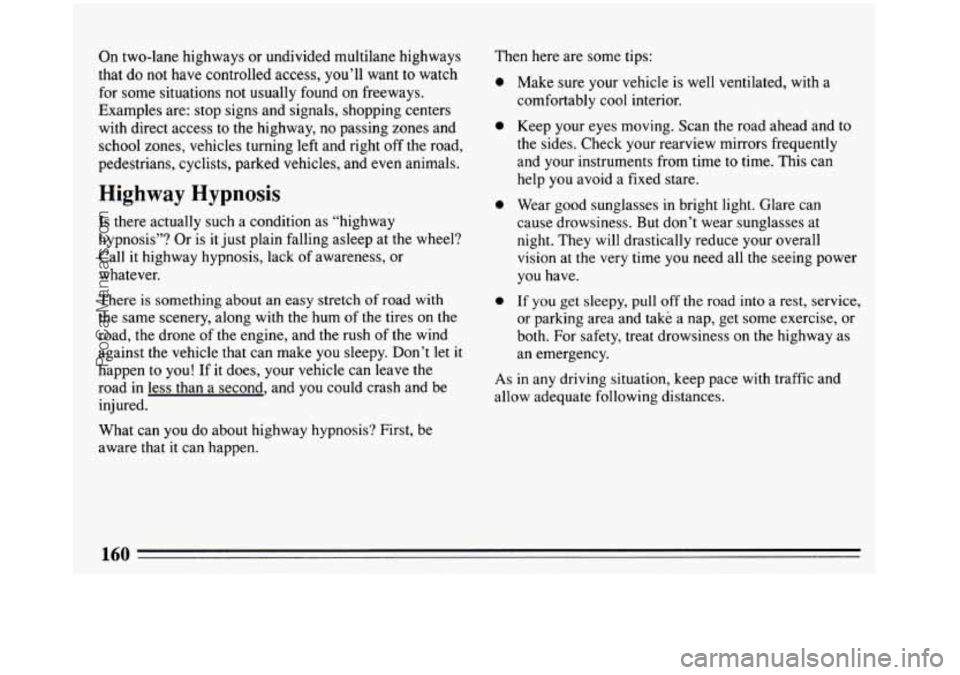
On two-lane highways or undivided multilane highways
that do not have controlled access, you’ll want to watch
for some situations not usually found on freeways.
Examples are: stop signs and signals, shopping centers
with direct access to the highway, no passing zones and
school zones, vehicles turning left and right
off the road,
pedestrians, cyclists, parked vehicles, and even animals.
Highway Hypnosis
Is there actually such a condition as “highway
hypnosis”? Or is it just plain falling asleep at the wheel?
Call it highway hypnosis, lack
of awareness, or
whatever.
There is something about an easy stretch
of road with
the same scenery, along with the hum of
the tires on the
road, the drone of the engine, and the rush
of the wind
against the vehicle that can make
you sleepy. Don’t let it
happen to
you! If it does, your vehicle can leave the
road in less than a second, and you could crash and be
inj ured.
What can you
do about highway hypnosis? First, be
aware that it can happen. Then
here are some tips:
0
0
0
0
Make sure your vehicle is well ventilated, with a
comfortably cool interior.
Keep your eyes moving. Scan the road ahead and to
the sides. Check your rearview mirrors frequently
and your instruments from time
to time. This can
help you avoid a fixed stare.
Wear good sunglasses in bright light. Glare can
cause drowsiness. But don’t wear sunglasses at
night. They will drastically reduce your overall
vision at
the very time you need all the seeing power
you have.
If you get sleepy, pull off the road into a rest, service,
or parking area and take a nap, get some exercise, or
both. For safety, treat drowsiness on
the highway as
an emergency.
As in any driving situation, keep pace with traffic and
allow adequate following distances.
ProCarManuals.com
Page 165 of 308
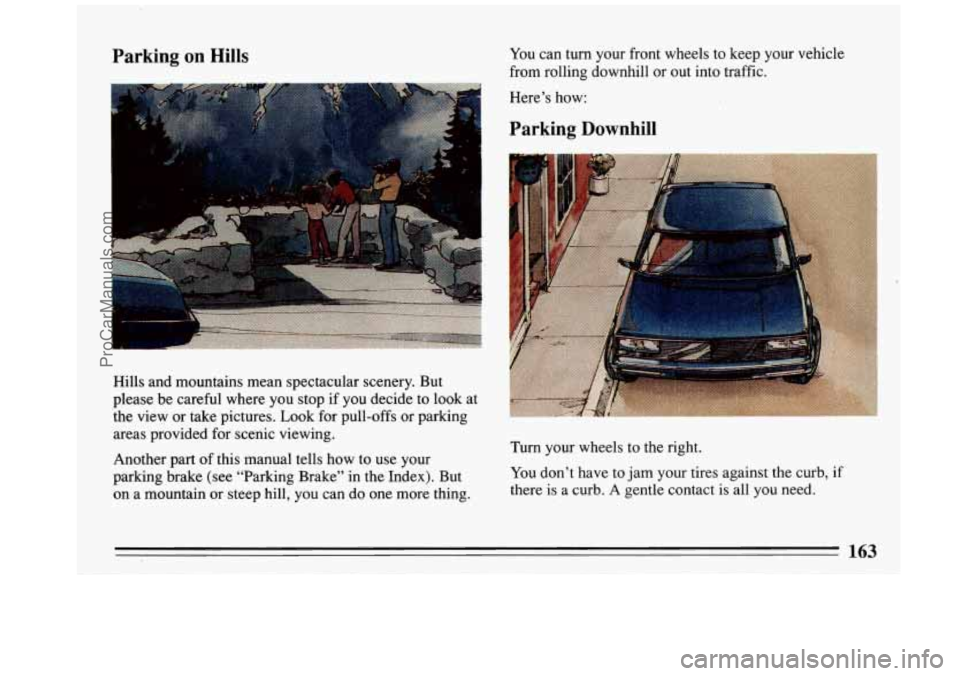
Parking on Hills You can turn your front wheels to keep your vehicle
from rolling downhill or out into traffic.
Hills and mountains mean spectacular scenery. But
please be careful where you stop if you decide to look at
the view or take pictures. Look for pull-offs or parking
areas provided for scenic viewing.
Another part of this manual tells how to use your
parking brake (see “Parking Brake” in the Index). But
on a mountain or steep hill, you can do one more thing. Turn
your wheels to the right.
You don’t have to jam your tires against the curb, if
there
is a curb. A gentle contact is all you need.
163
ProCarManuals.com
Page 168 of 308

Winter Driving
Here are some tips for winter driving:
Have your Buick in good shape for winter. Be sure
your engine coolant mix is correct.
0 Snow tires can help in loose snow, but they may give
you less traction on ice than regular tires. If you do
not expect to be driving in deep snow, but may have
to travel over ice, you may not want to switch to
snow tires at all.
You may want to put winter emergency supplies in
your trunk.
Include an ice scraper, a small brush or broom,
a supply
of windshield washer fluid,
a rag, some winter outer
clothing,
a small shovel, a flashlight, a red cloth, and a
couple of reflective warning triangles. And, if you will
be driving under severe conditions, include
a small bag
of sand, a piece of old carpet or a couple
of burlap bags
to help provide traction. Be sure you properly secure
these items
in your vehicle.
166
ProCarManuals.com
Page 169 of 308
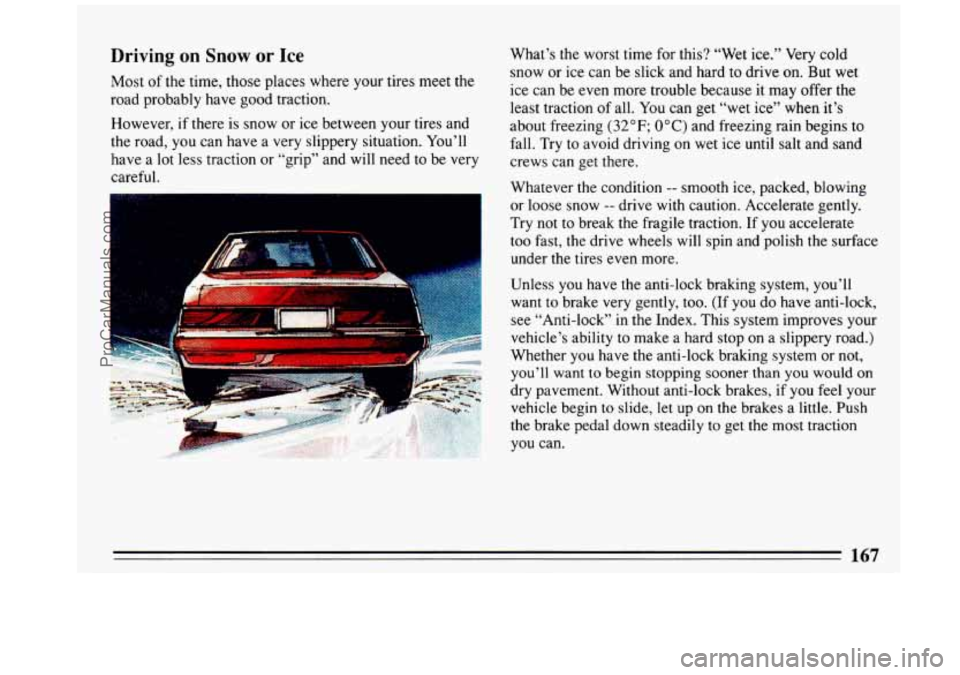
Driving on Snow or Ice
Most of the time, those places where your tires meet the
road probably have good traction.
However,
if there is snow or ice between your tires and
the road, you can have
a very slippery situation. You’ll
have a lot less traction or “grip” and will need to be very
careful.
-.*
9
What’s the worst time for this? “Wet ice.” Very cold
snow or ice can be slick and hard to drive on. But wet
ice can be even more trouble because it may offer the
least traction of all. You can get “wet ice” when it’s
about freezing
(32 OF; 0 O C) and freezing rain begins to
fall. Try to avoid driving on wet
ice until salt and sand
crews can get there.
Whatever the condition
-- smooth ice, packed, blowing
or loose snow
-- drive with caution. Accelerate gently.
Try
not to break the fragile traction. If you accelerate
too fast, the drive wheels will spin and polish the surface
under the tires even more.
Unless you have the anti-lock braking system, you’ll
want to brake very gently,
too. (If you do have anti-lock,
see “Anti-lock” in the Index. This system improves your
vehicle’s ability to make a hard stop on a slippery road.)
Whether you have the anti-lock braking system or not,
you’ll want to begin stopping sooner than you would on
dry pavement. Without anti-lock brakes, if you feel your
vehicle begin to slide, let up
on the brakes a little. Push
the brake pedal down steadily to get the most traction
you can.
167
ProCarManuals.com
Page 172 of 308
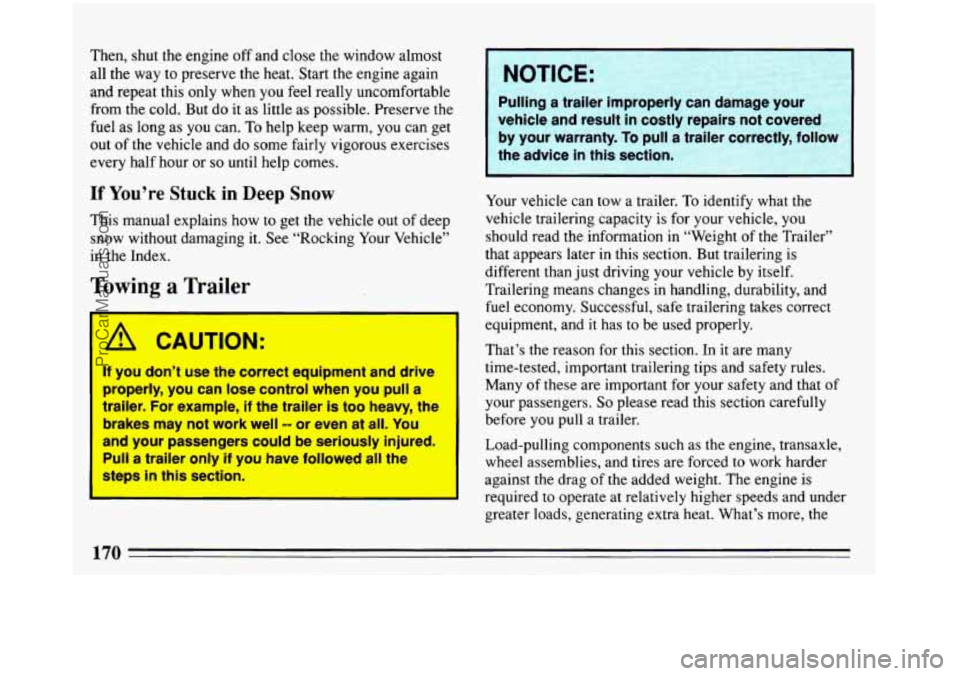
Then, shut the engine off and close the window almost
all the way to preserve the heat. Start the engine again
and repeat this only when you
feel really uncomfortable
from the cold. But do it as little
as possible. Preserve the
fuel as long as you can.
To help keep warm, you can get
out
of the vehicle and do some fairly vigorous exercises
every half hour
or so until help comes.
If You’re Stuck in Deep Snow
This manual explains how to get the vehicle out of deep
snow without damaging it. See “Rocking Your Vehicle”
in the Index.
Towing a Trailer
(n CAUTION:
If you don’t use the correct equipment and drive
properly, you can
lose control when you pull a
trailer. For example,
if the trailer is too heavy, the
brakes may not work well
-- or even at all. You
and your passengers could be seriously injured.
Pull a trailer only if you have followed all the
steps
in this section.
I NOTICE:
Pulling a trailer improperly can damage your
vehicle and result
in costly repairs not covered
by your warranty.
To pull a trailer correctly, follov
the advice in this section. ‘I
Your vehicle can tow a trailer. To identify what the
vehicle trailering capacity is for your vehicle, you
should read the information in “Weight
of the Trailer”
that appears later in this section. But trailering is
different than just driving your vehicle by itself.
Trailering means changes in handling, durability, and
fuel economy. Successful, safe trailering takes correct
equipment, and it has
to be used properly.
That’s the reason for this section. In
it are many
time-tested, important trailering tips and safety rules.
Many
of these are important for your safety and that of
your passengers.
So please read this section carefully
before
you pull a trailer.
Load-pulling components such as the engine, transaxle,
wheel assemblies, and tires are forced to work harder
against the drag of the added weight. The engine is
required to operate at relatively higher speeds and under
greater loads, generating extra heat. What’s more, the
170
- -
ProCarManuals.com
Page 174 of 308
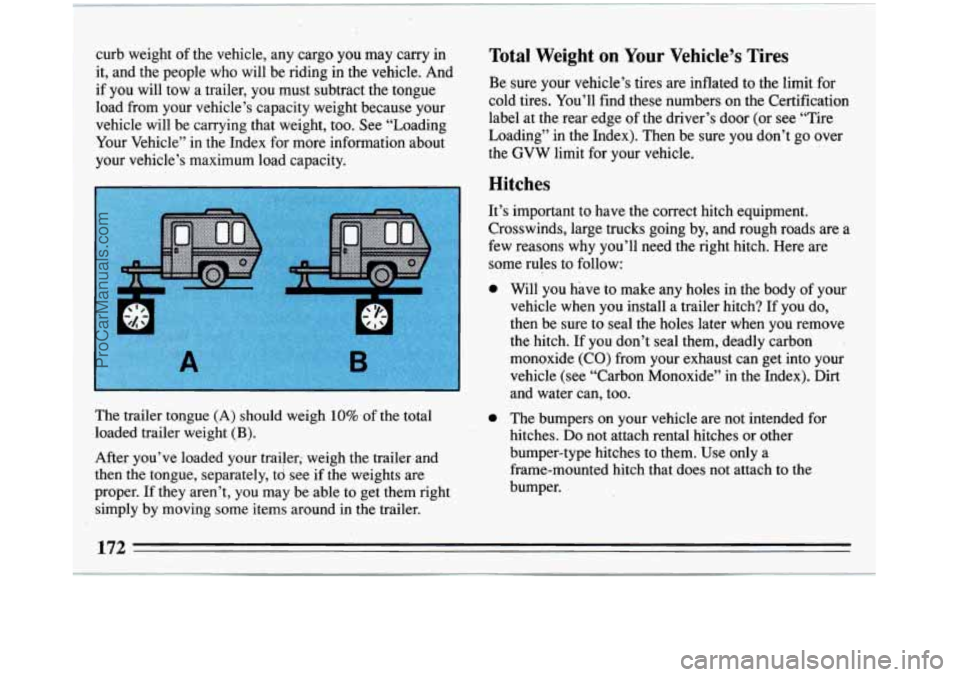
curb weight of the vehicle, any cargo you may carry in Total Weight on Your Vehicle’s Tires
it, and the people who will be riding in the vehicle. And
if you will tow a trailer, you must subtract the tongue
load from your vehicle’s capacity weight because your
vehicle will be carrying that weight, too. See “Loading
Your Vehicle” in the Index for more information about
your vehicle’s maximum load capacity.
-
Be sure your vehicle’s tires are inflated to the limit for
cold tires. You’ll find these numbers on the Certification
label at the rear edge of the driver’s door (or see “Tire
Loading’’ in the Index). Then be sure you don’t go over
the GVW limit €or your vehicle.
Hitches
It’s important to have the correct hitch equipment.
Crosswinds, large trucks going by, and rough roads are a
few reasons why you’ll need the right hitch. Here are
some rules to follow:
0
The trailer tongue (A) should weigh 10% of the total
,loaded trailer weight
(B).
After you’ve loaded your trailer; weigh the trailer,and
then the tongue, separately,
td see if the weights are
proper.
If they aren’t, you may be able to get them right
simply by moving some items around in the trailer.
0
Will you have to make any holes in the body of your
vehicle when you install a trailer hitch? If you do,
then be sure to seal the holes later when you remove
the hitch.
If you don’t seal them, deadly carbon
monoxide (CO) from your exhaust can get into your
vehicle (see “Carbon Monoxide’’ in the Index). Dirt
and ‘water can, too:
The bumpers on your vehicle are not intended for
hitches.
Do not attach rental hitches or other
bumper-type hitches to them. Use only a
frame-mounted hitch that does not attach to the
bumper.
172
ProCarManuals.com
Page 175 of 308
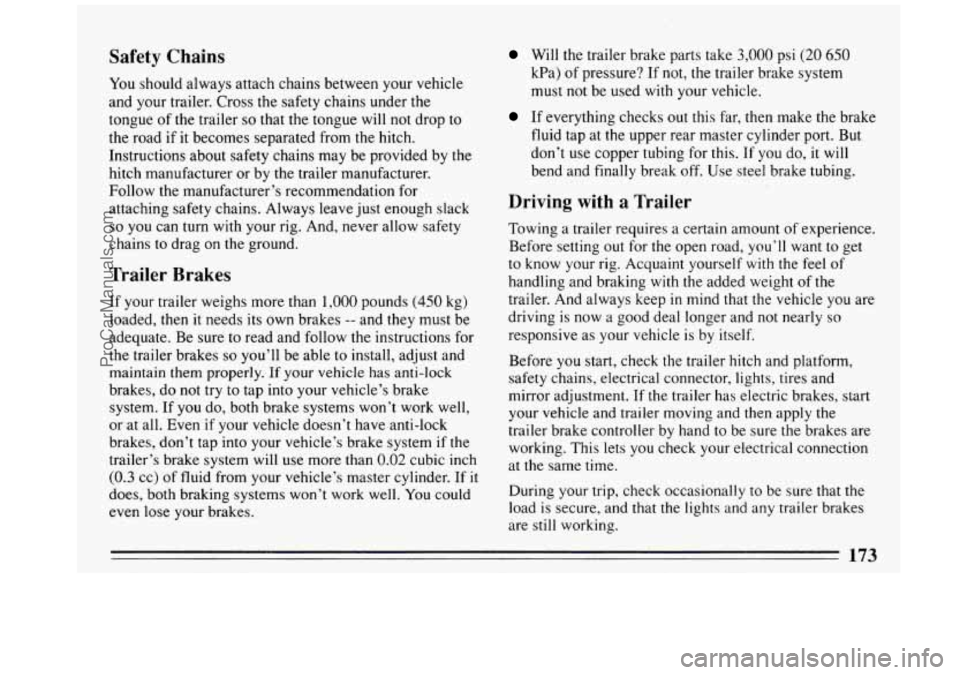
Safety Chains
You should always attach chains between your vehicle
and your trailer. Cross the safety chains under the
tongue of the trailer
so that the tongue will not drop to
the road if it becomes separated from the hitch.
Instructions about safety chains may be provided by the
hitch manufacturer or by the trailer manufacturer.
Follow the manufacturer’s recommendation for
attaching safety chains. Always leave just enough slack
so you can turn with your rig. And, never allow safety
chains to drag on the ground.
Trailer Brakes
If your trailer weighs more than 1,000 pounds (450 kg)
loaded, then it needs
its own brakes -- and they must be
adequate. Be sure
to read and follow the instructions for
the trailer brakes
so you’ll be able to install, adjust and
maintain them properly. If your vehicle has anti-lock
brakes, do not try
to tap into your vehicle’s brake
system. If you do, both brake systems won’t work well,
or at all. Even if your vehicle doesn’t have anti-lock
brakes, don’t tap into your vehicle’s brake system if
the
trailer’s brake system will use more than 0.02 cubic inch
(0.3 cc) of fluid from your vehicle’s master cylinder. If it
does, both braking systems won’t work well.
You could
even
lose your brakes.
Will the trailer brake parts take 3,000 psi (20 650
kPa) of pressure? If not, the trailer brake system
must not be used with your vehicle.
If everything checks out this far, then make the brake
fluid tap at the upper rear master cylinder port. But
don’t
use copper tubing for this. If you do, it will
bend and finally break
off. Use steel brake tubing.
Driving with a Trailer
Towing a trailer requires a certain amount of experience.
Before setting out for
the open road, you’ll want to get
to know your rig. Acquaint yourself with the feel of
handling and braking with the added weight of the
trailer. And always keep
in mind that the vehicle you are
driving is
now a good deal longer and not nearly so
responsive as your vehicle is by itself.
Before you start, check the trailer hitch and platform,
safety chains, electrical connector, lights, tires and
mirror adjustment. If the trailer has electric brakes, start
your vehicle and trailer moving and then apply the
trailer brake controller by hand to be sure
the brakes are
working. This lets you check your electrical connection
at the same time.
During your trip, check occasionally
to be sure that the
load is secure, and that the lights and any trailer brakes
are still working.
172
ProCarManuals.com
Page 187 of 308
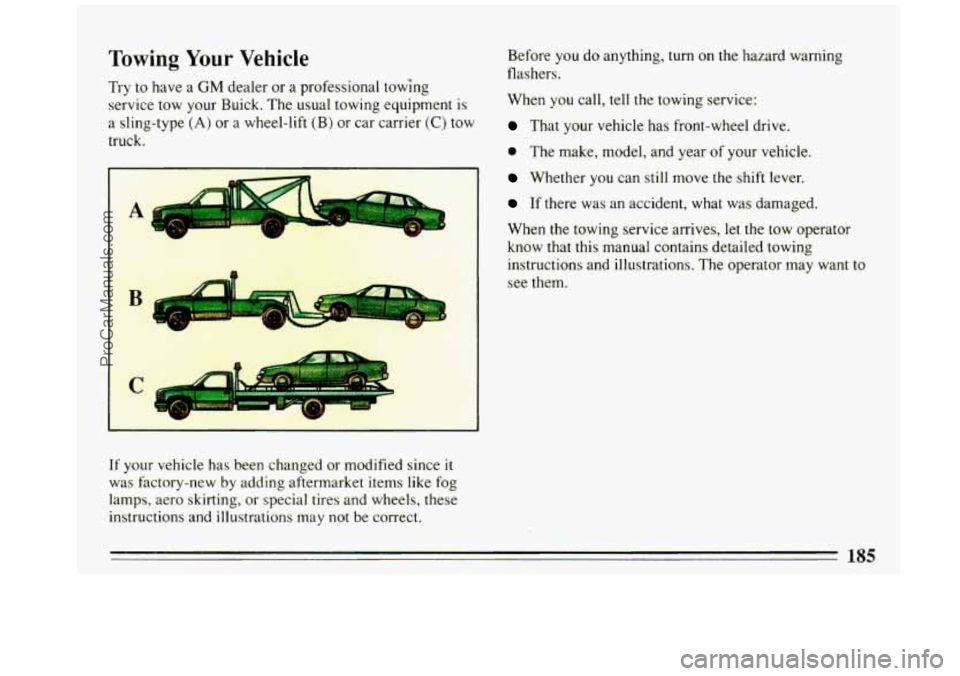
Towing Your Vehicle
Try to have a GM dealer or a professional towing
service tow your Ruick. The usual towing equipment
is
a sling-type (A) or a wheel-lift (B) or car carrier (C) tow
truck.
If your vehicle has been changed or modified since it
was factory-new by adding aftermarket items like fog
lamps, aero skirting, or special tires
and wheels, these
instructions and illustrations may not
be correct. Before
you do anything,
turn on the hazard warning
flashers.
When you call, tell the towing service:
That your vehicle has front-wheel drive.
0 The make, model, and year of your vehicle.
Whether you can still move the shift lever.
If there was an accident, what was damaged.
When
the towing service arrives, let the tow operator
know that this manual contains detailed towing
instructions and illustrations. The operator may want to
see them.
ProCarManuals.com